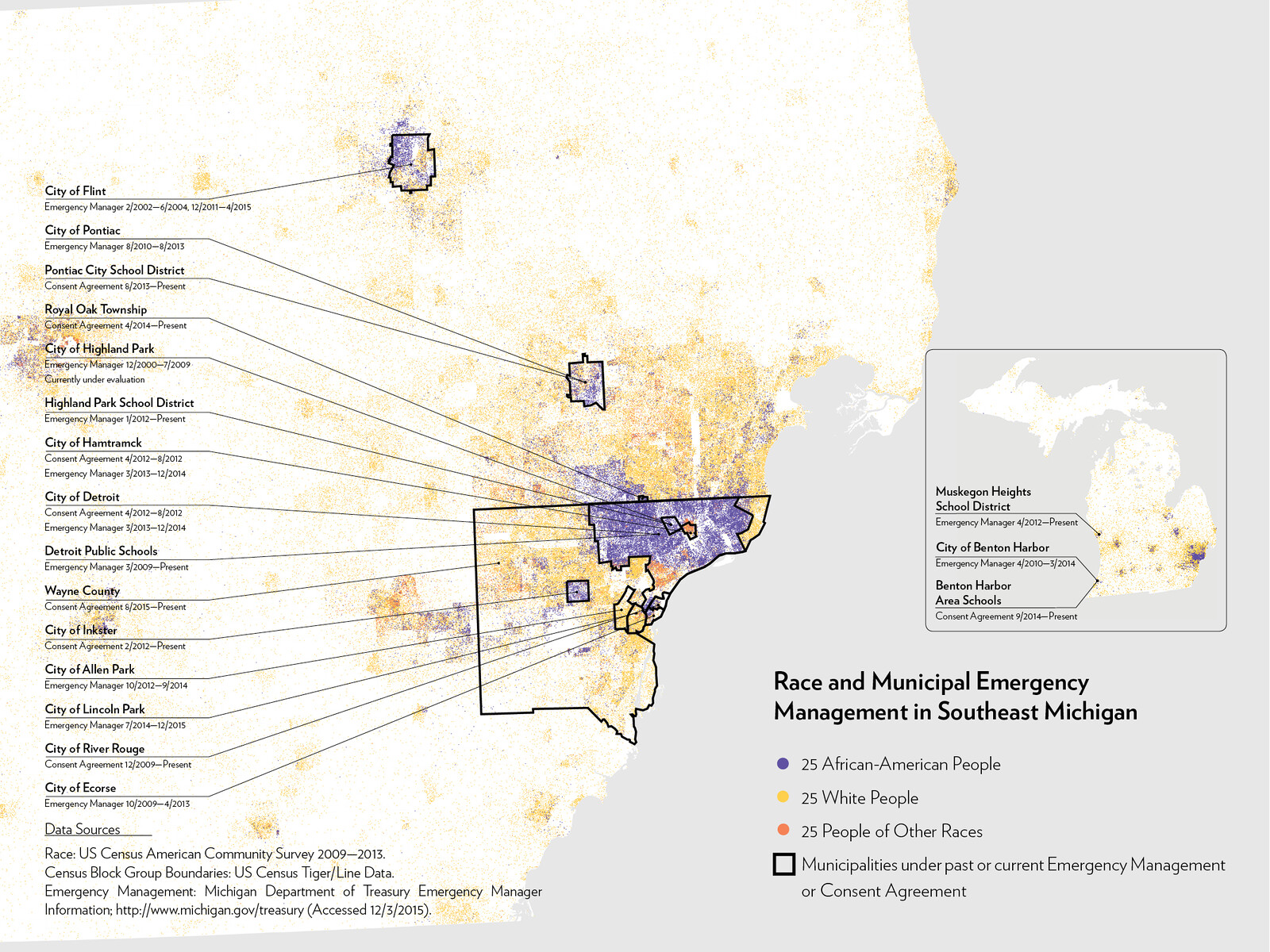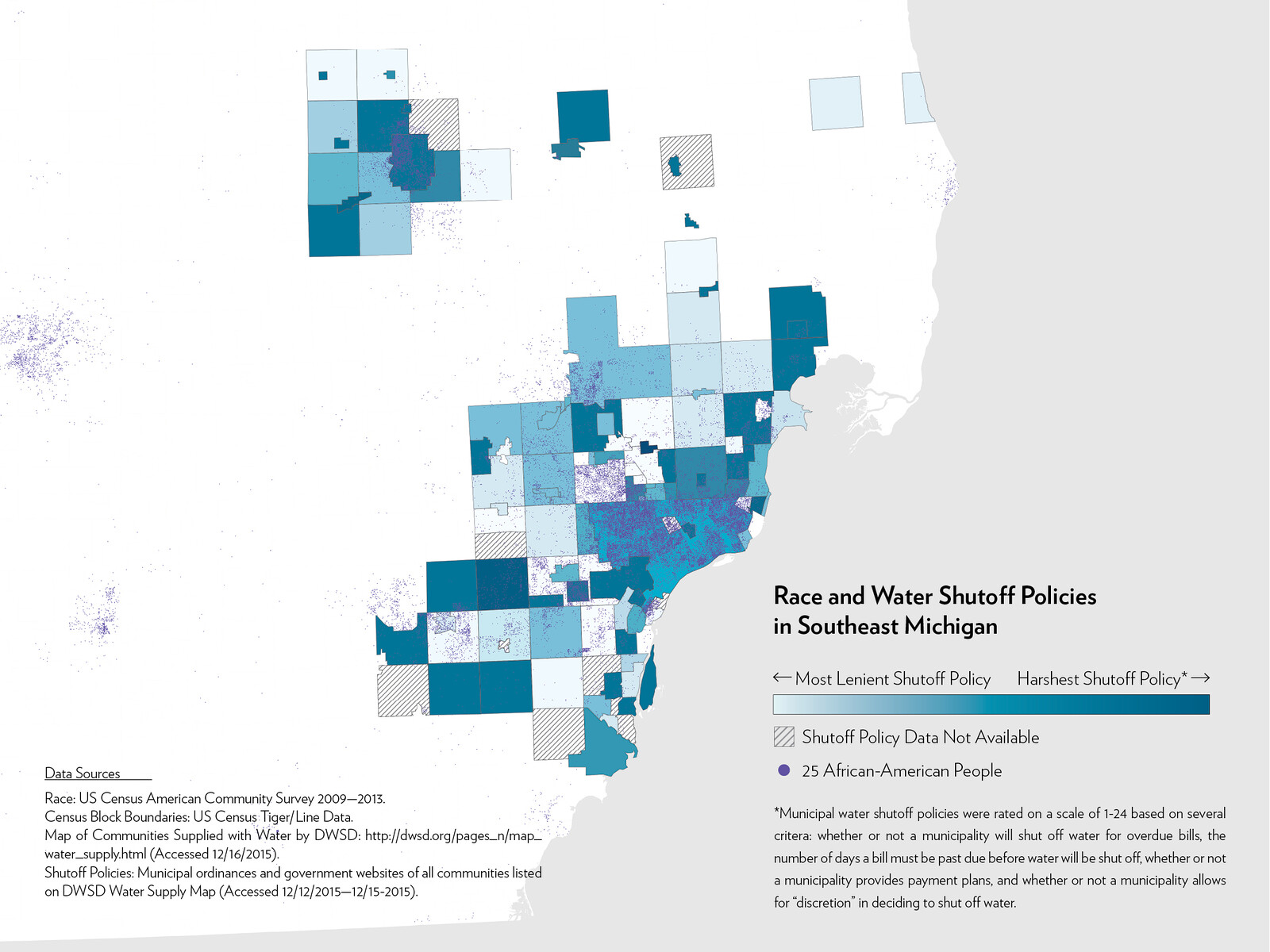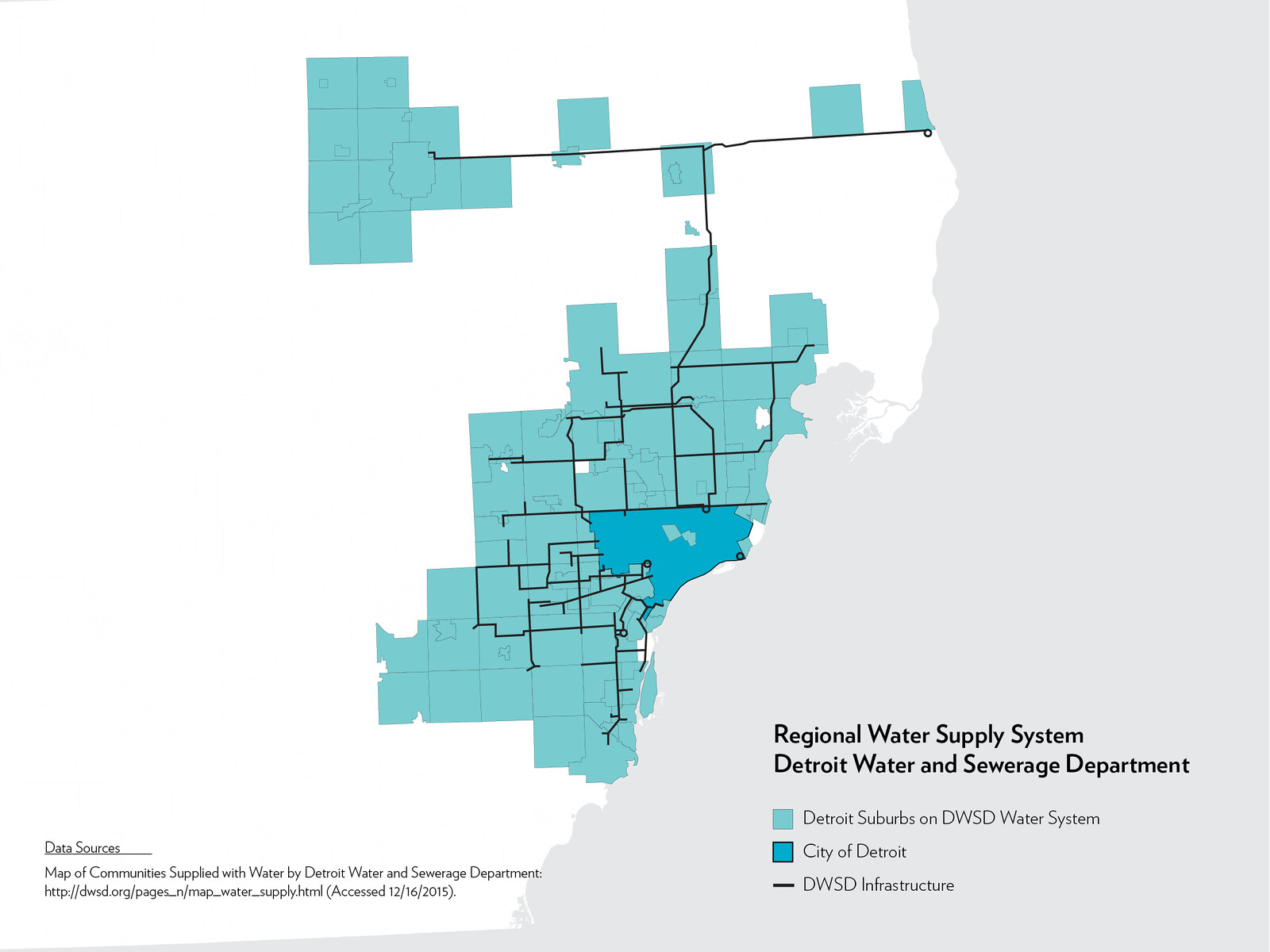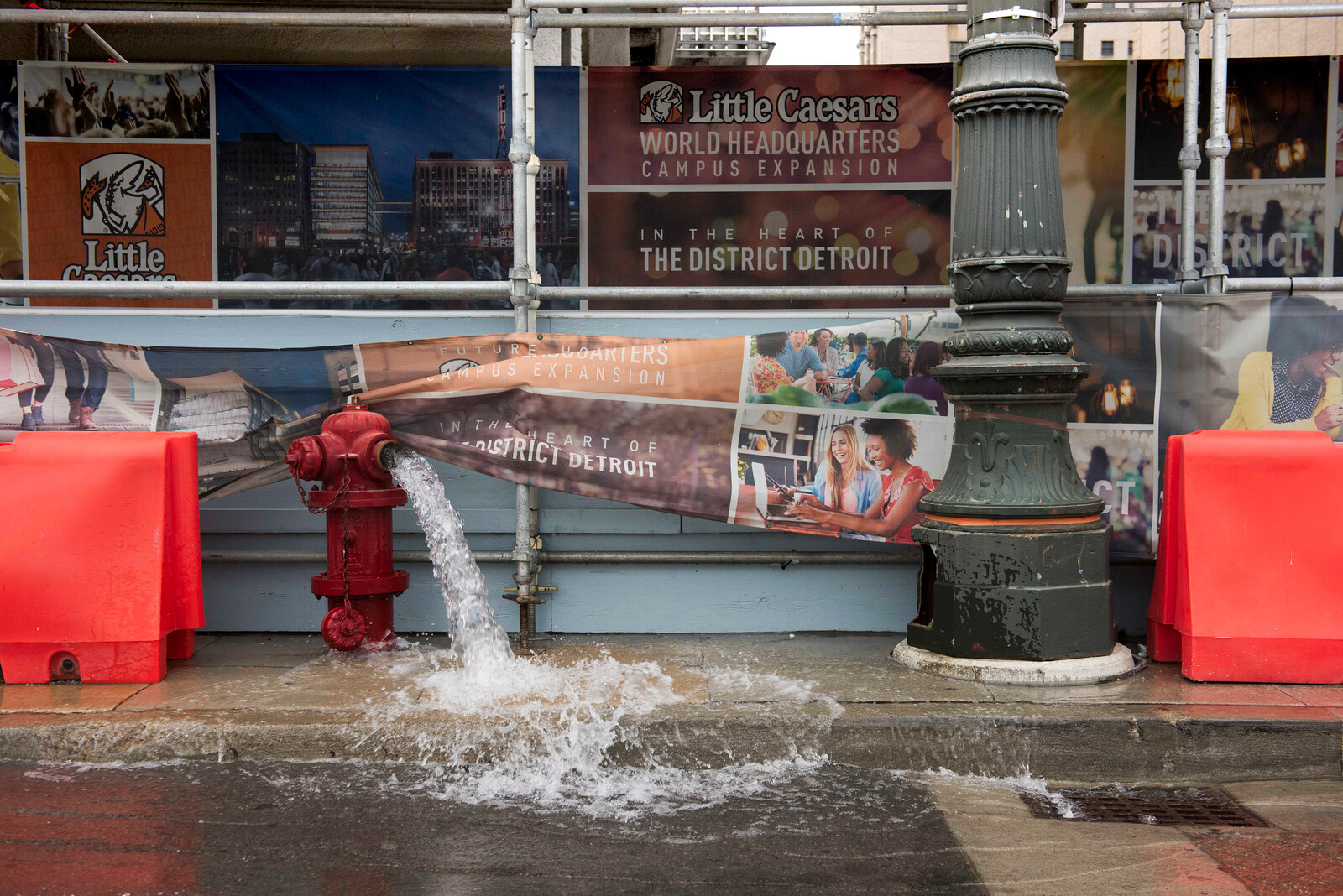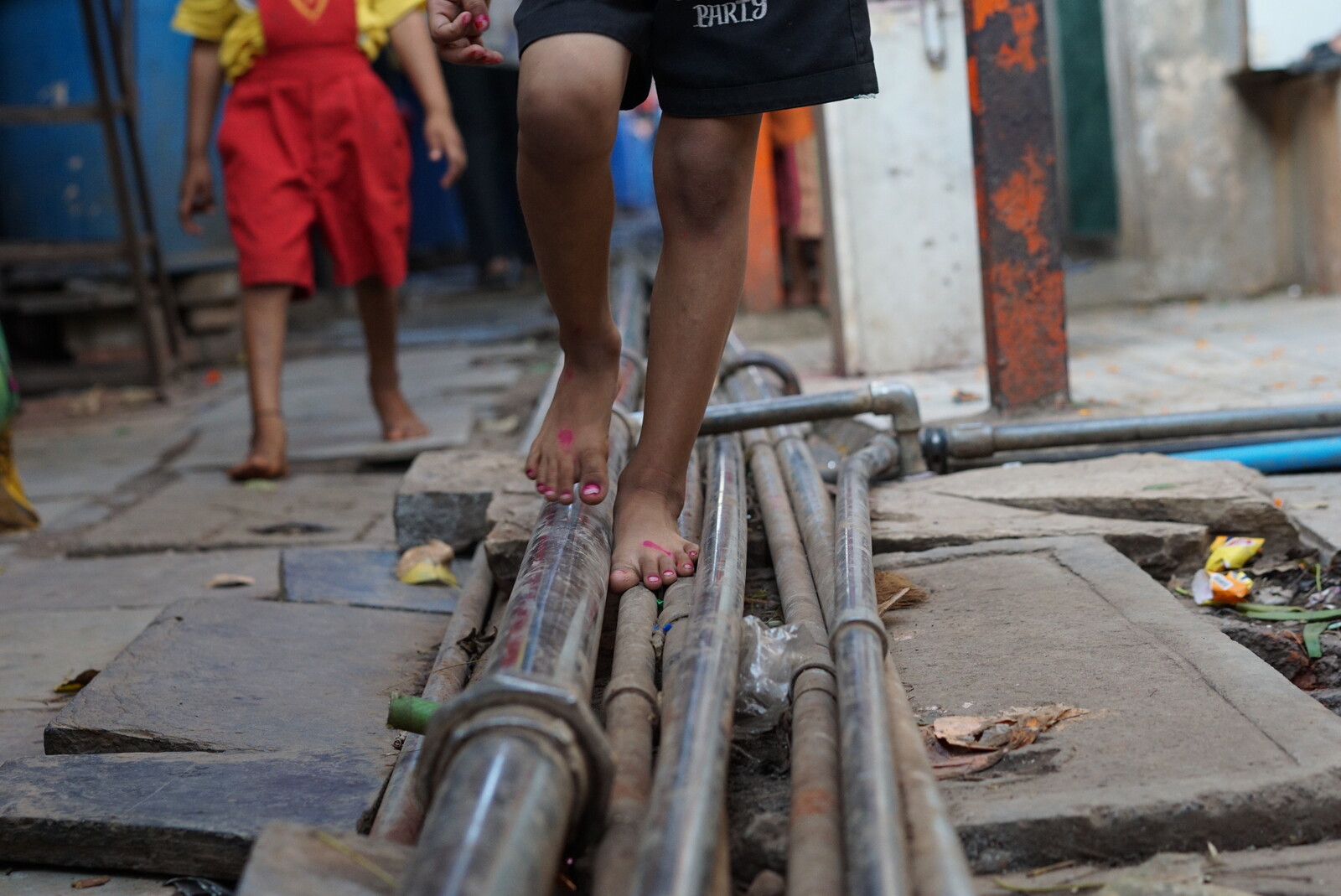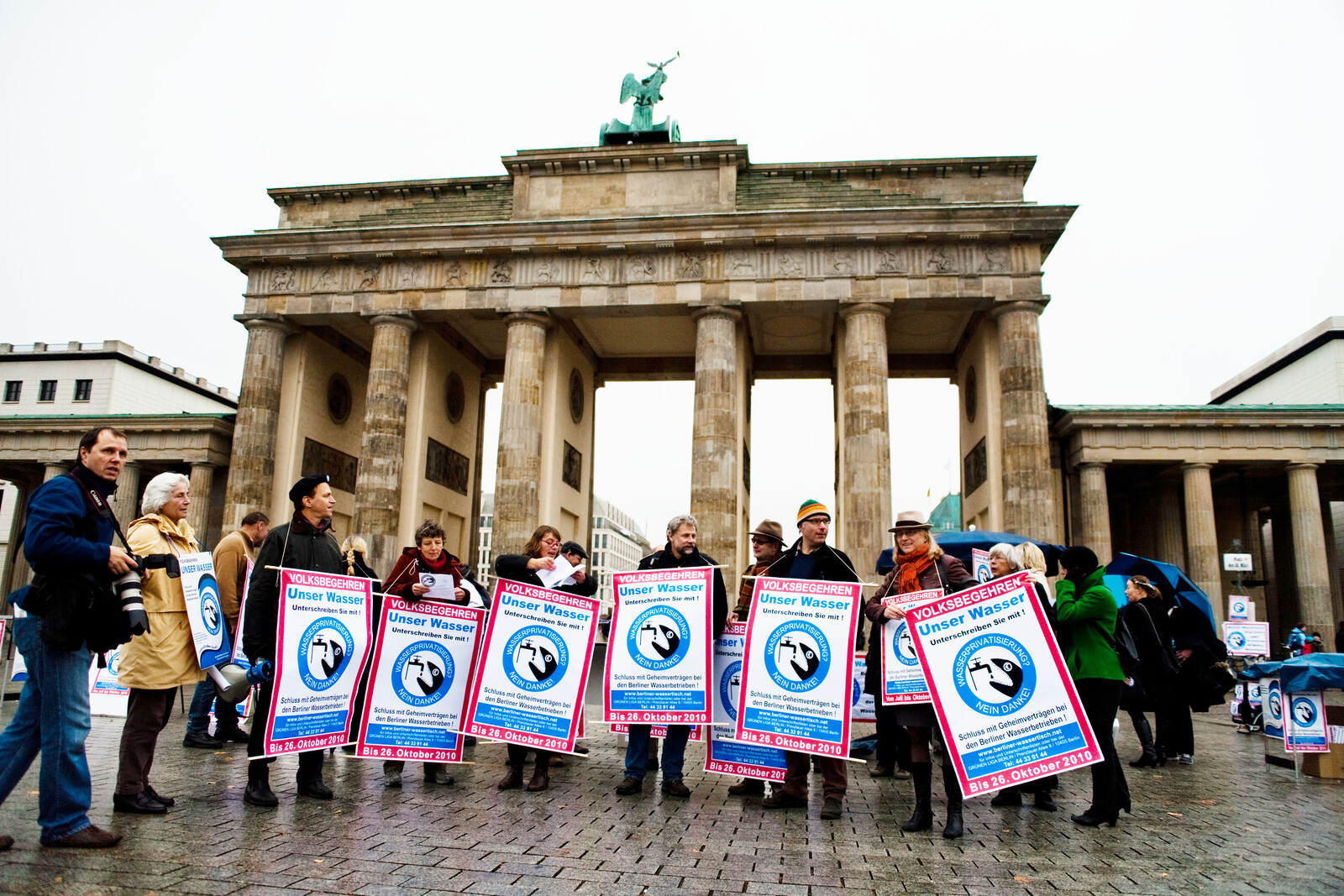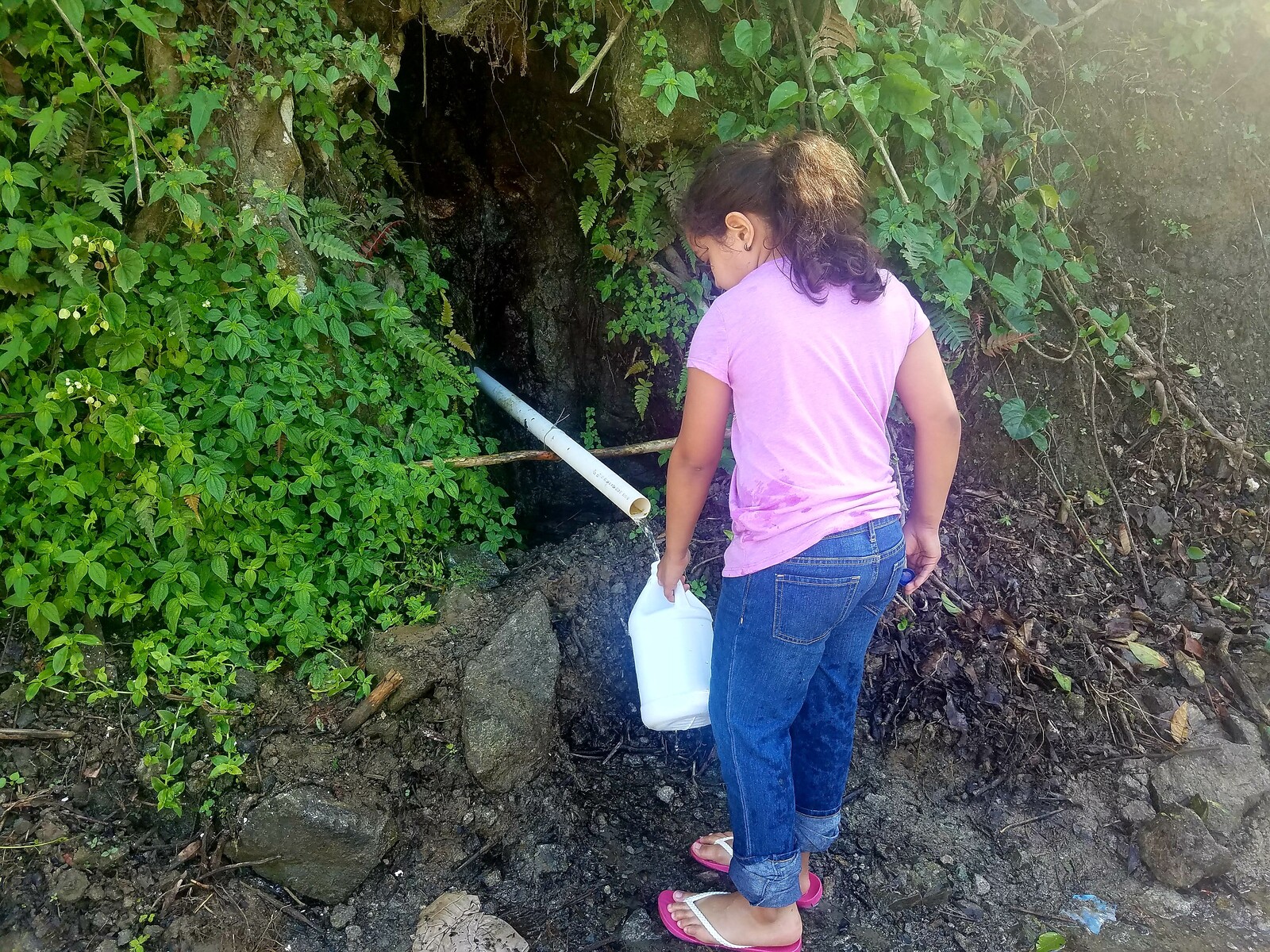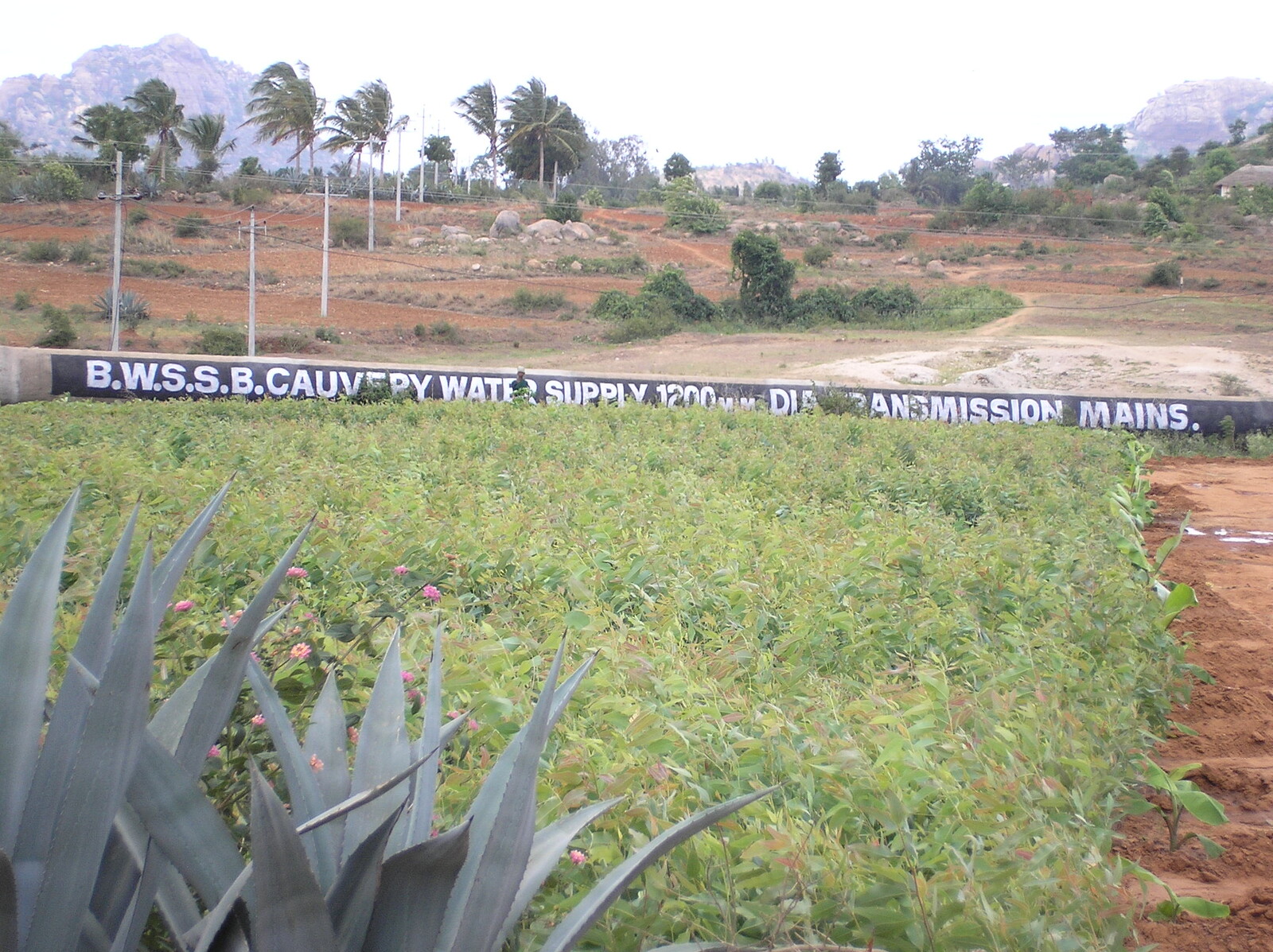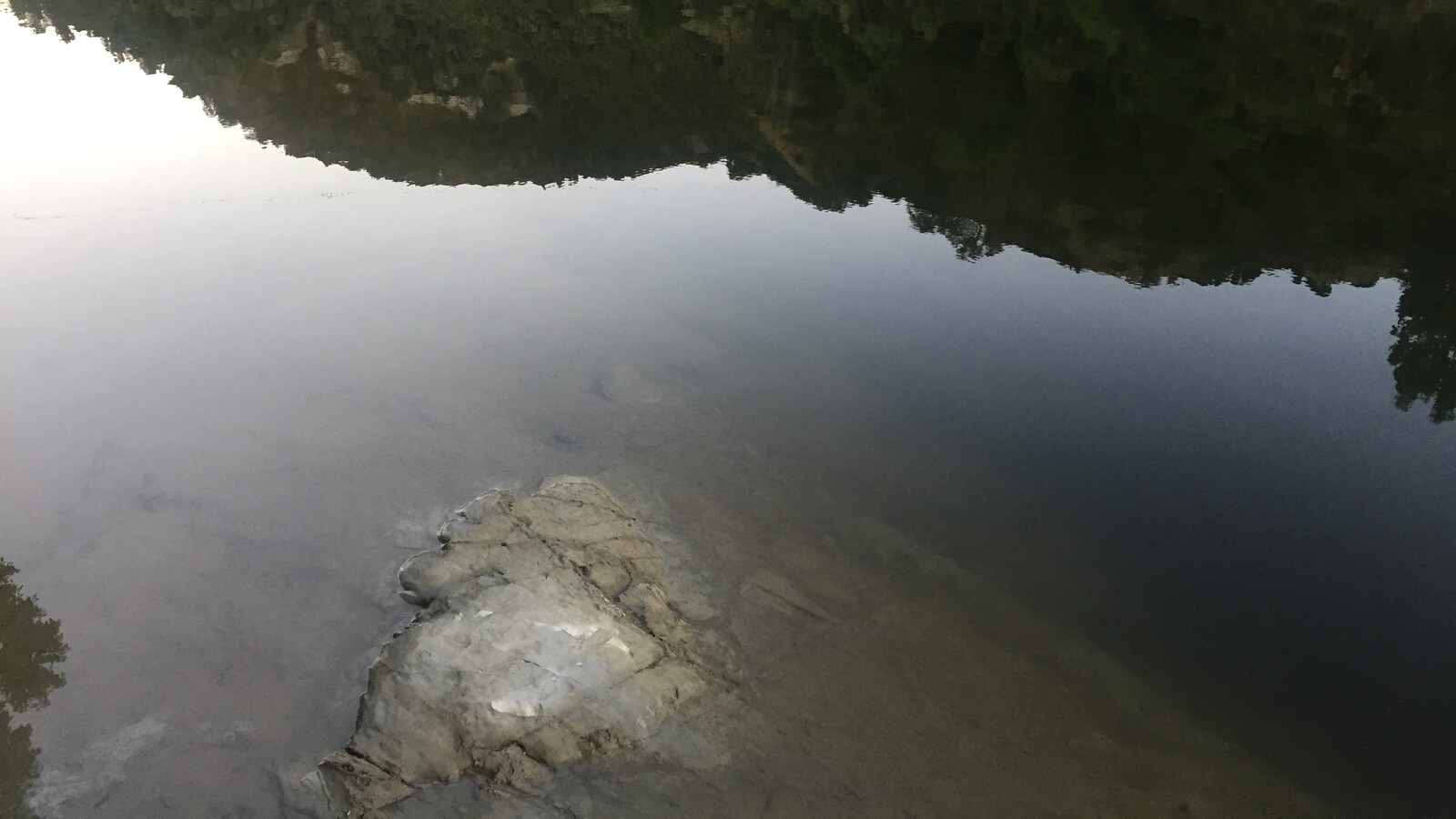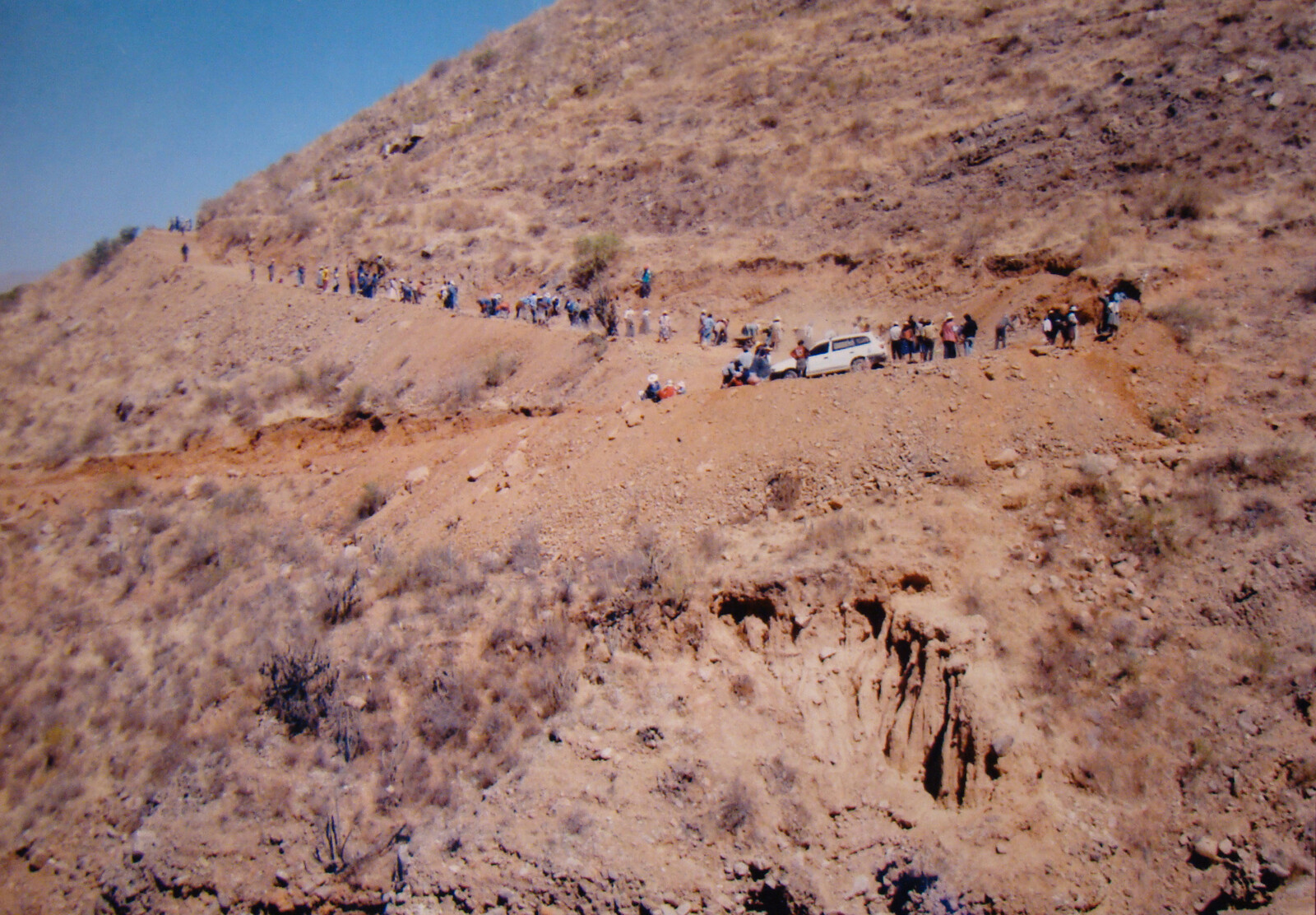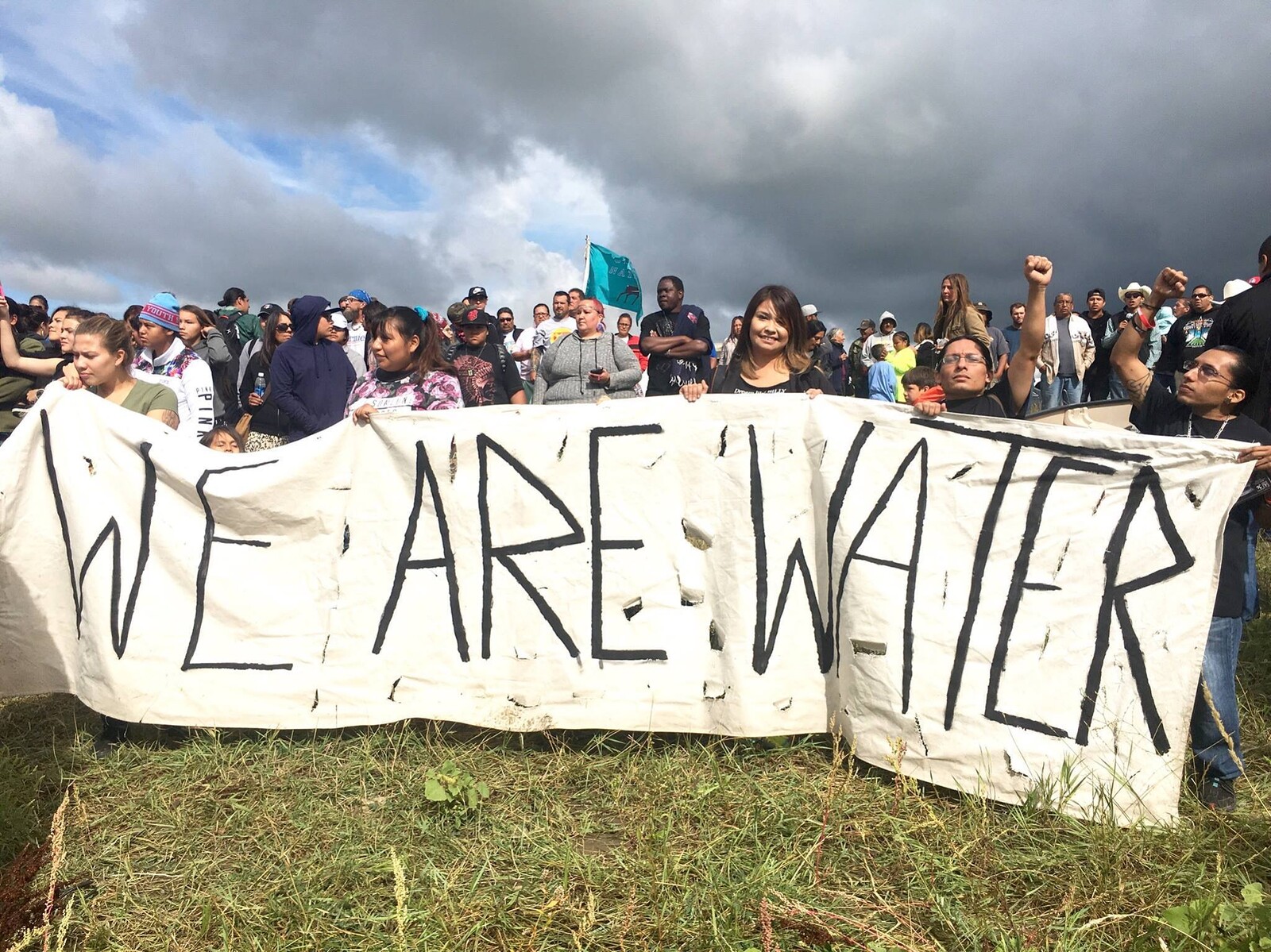In the shadows of Elmwood Cemetery on Detroit’s east side, Bloody Run Creek flows freely. Most of its waters have been buried by urban development, but there, protected by the dead of centuries, it flows through land still shaped by the forces of wind and water, rising and falling with the seasons. The stream takes its name from the blood of British soldiers killed by Chief Pontiac and his men in 1763. Pontiac had amassed one of the first anti-colonialist armies, uniting forces throughout the upper Midwest against the British Empire. Resistance, like water, flows through Detroit.1
As a place of resistance, Detroit continues to capture the imagination. It evokes images of decay and renewal, invention and corruption, fury and hope. Struggling against the most destructive forces of empire and capital, from the British imperialists of the colonial era to the neoliberal agendas of the twenty-first century, Detroiters have always been at the forefront of developing new practices of democracy and enlarging collective understandings of meaningful urban life.2 Prior to the civil war, Detroit offered sanctuary and escape to people fleeing bondage, and over a century later, in the 1980s, it drew on that heritage to become a sanctuary city, offering haven to those who challenged United States military actions in Central America. In the early twentieth century, Detroiters organized for the dignity of working people, engaging in strikes, sit-ins, and walk-outs. In the mid-century, Detroit gave rise to black liberation, creating a host of organizations and actions including the Dodge Revolutionary Union Movement, Shire of the Black Madonna, Republic of New Africa, and the National Organization for an American Revolution. Detroit established the first independent Feminist Economic Network, is a leader in environmental justice, and declared itself a nuclear free zone.
The waters of the Great Lakes have long defined Detroit. Lakes, rivers, and streams once etched the landscape, connecting its first people in a vast web of land and water routes. Some called it Bending River, others the Land Along the Coasts. In 1701 the French colonists called it de`Toit, “the straits.” Here people gathered to celebrate, to exchange ideas, and to find the sustenance of life.3
The Great Lakes hold twenty-two percent of the earth’s fresh surface water, much of which flows through the Detroit River as it narrows and bends through the city. Over the centuries, these waters have sustained communities, provided routes to connect diverse cultures, been abused and defiled, placed at risk, and vigorously protected. Today the Detroit water system supports more than four million people. Yet it is also being used as a weapon. Policies surrounding water in Detroit are driving African American and poor people from the city, freeing up land and resources for white corporate development. The creation of financial emergencies by state policies and executives is central to that reassertion of control.
Emergency Management
Across the United States in the early 1980s, right wing forces gained political power and enacted measures promoting financial austerity and limiting democratic decision-making.4 Michigan, governed by increasingly ideological right-wing forces, has created one of the most draconian legislative frameworks for such actions. Since the late 1980s, Michigan has used emergency management—which sets aside local democratic processes and grants broad powers to a single individual—more than any other state. In their 2016 analysis of the impact of emergency management in Michigan, Shawna J. Lee, Amy Krings, Sara Rose, Krista Dover, Jessica Ayoub, and Fatima Salman argue that these polices are not “race neutral,” but have severely impacted both the economic well-being and political power of people of color. They document that at some point from 2008–2013, of the “10.1% of Michigan residents under emergency management, 70.7% were African American and 7.3% were Hispanic or Latino,” noting that while African Americans make up only fourteen percent of Michigan’s population, “51% of African Americans in Michigan were under an emergency manager.” They further explain that during the same period, “only 2.4% of Whites were under emergency management, although they make up 76.6% of the population.”5 The disproportionate impact of emergency management on communities of color provided the basis for the Center for Constitutional Rights to challenge the state law establishing the process of emergency management in 2017 as a violation of the Equal Protection Clause of the Fourteenth Amendment, arguing that “since 2013, at one point or another, 56% of the black population of the state of Michigan has lived under emergency management.”6
Emergency managers (EMs) are appointed to resolve financial crises that are often created by state actions. In a careful analysis of the drive to bankruptcy by the state in Detroit, Wallace Turbeville explains how state legislative decisions to reduce revenue sharing to the city fostered the financial crisis in Detroit. For Turbeville, the image of Detroit as incompetent and corrupt was foundational for the refusal to look at the full political context of the city’s financial problems. He concludes:
In the city of Detroit, the emergency manager was able to create the perception that the city’s travails were a consequence of spending and poor management rather than a decline of revenue sources. This messaging was in his interest in that it enhanced the legitimacy of his position, but it is also reflective of the likely discourse between cities experiencing fiscal difficulties and their state governments. This is heightened by the political and ideological divisions between state and city administrations.7
In predominantly African American cities across Michigan, elected officials have been removed from power, city services cut back and privatized, and public assets sold off. For example, in Benton Harbor, a local park serving a public housing project was turned into a private golf course.8 In Pontiac, the EM outsourced water treatment to a private company indicted for violating the Clean Water Act.9 The decisions to remove Flint from the Detroit water system and to take water from the Flint River instead were made by emergency managers.
Jamie Peck and Heather Whiteside call these efforts at imposing urban austerity the “financialization of American urban governance.” Peck and Whiteside show how neoliberal strategies have evolved beyond “the tyranny of tight budgets” toward “a profound restructuring of the institutions of urban governance.”10 This restructuring has ushered in what they define as a “postdemocratic” form of municipal governance that uses financial crises to justify supplanting local democracies with state-appointed emergency managers.
Emergency management in Michigan has been resisted at every stage, forcing right-wing legislators to continually refine their efforts. Opposition has included civil disobedience, petition drives, a state-wide referendum to overturn enabling legislation, public protests, court challenges, public theater, alternative media production, and intense organizing of opposition voices and alternative strategies.
Assault on the Right to Water
The ability of emergency management to bypass local government, to set aside union contracts, and shift public responsibilities to the private sector depends on fostering racial antagonisms and the view that people of color are incapable of self-government.11 Combining the drive for reduced government spending with the argument that people in urban areas are incompetent and corrupt led the Detroit Water and Sewerage System (DWSD) to be transferred into the hands of suburban control, while continuing to extract wealth from the city’s residents. Racial antagonisms between Detroit and its suburban neighbors have evolved over centuries, but with the uprisings in 1967, race-based segregation and the image of the city as a place of violence and corruption was enshrined in the suburban imagination. By 1970, Detroit and the surrounding suburban areas were the “most segregated metro area in the country.”12 This racial divide expresses itself in every dimension of life in Detroit. Charles Williams, leader of Detroit’s National Action Network recently remarked that “the politics of division, of race, have been drilled into the fabric” of the city.13
The corollary suburban view is reflected in the comments of the executive leader of Oakland County, L. Brooks Patterson. Oakland County, which borders Detroit to the north, is one of the wealthiest suburbs in the nation. In the midst of the city’s bankruptcy process, Patterson gave an interview to the New Yorker titled “Drop Dead, Detroit!” After explaining that he did not want his children to go into the city for fear of crime, he responded to the question of how Detroit might fix its financial problems by saying, “I made a prediction a long time ago, and it’s come to pass. I said, ‘What we’re gonna do is turn Detroit into an Indian reservation, where we herd all the Indians into the city, build a fence around it, and then throw in the blankets and corn.’”14 While these comments ignited a firestorm, they were vintage Patterson, who once said of an African American Councilwoman he would rather “own a 1947 Buick than own her.” When Kevyn Orr was appointed Emergency Manager, he was quoted in the Wall Street Journal describing Detroiters as “dumb, lazy, happy, and rich.”15 Racialized logics of corruption and incompetence have been essential to shifting public assets away from the city.
From the very first assertions of Black Power and the election of Coleman Young as the first African American mayor, the city has faced relentless efforts by the white power structure to take control of public assets while disempowering people. For example, between 1977 and 2013, Detroit did not control its water department, but was instead under an Environmental Protection Agency (EPA) consent decree because of clean water violations. For most of that time, Federal Judge John Feikens—an open racist and long-standing opponent of integration—was in charge of the DWSD.16 Through his appointees, union jobs were cut, especially in maintenance and repair, and outsourcing to the private sector became a common practice.
On March 27, 2013 United States District Judge Sean Cox ordered the return of the Water and Sewerage Department to Detroit, ending more than thirty-five years of federal oversight. This decision enabled the city’s newly appointed Emergency Manager, Kevyn Orr, to list the sprawling water system as an asset in the Detroit bankruptcy process taking place at that time.17 Orr said he would sell the department to address part of the debt, and in order to make it more attractive on the open market, he ordered a crack-down on overdue residential water bills. This set off an assault on Detroit’s communities that brought condemnation from the United Nations as a violation of human rights.18
More than 100,000 people in Detroit have faced water shutoffs as a result of Orr’s effort to collect outstanding payments. At the time of his appointment, as much as one third of the city was behind on ever-escalating water bills. In a city that’s eighty percent African American, more than thirty-five percent of residents live in poverty, the highest rate among the nation’s twenty largest cities. Unemployment hovers around nine percent, and the median income is around $28,000. Yet water rates have increased as much as 400 percent in the last twenty years.19
The Detroit water system was built to serve two million people and a heavy industrial infrastructure. As the plants closed and people left the city following World War II, the cost to maintain this core structure remained the same, but was being shouldered only by those that remained. Today, 700,000 people pay for a system built for two million, which creates higher charges for its customers. In the decade prior to bankruptcy, Detroiters experienced a 119 percent increase in water bills.20 In 2017, Michigan State University researchers documented that the median city household spends about $1,620 on water bills annually, roughly 6.5 percent of a poverty-line income.21 Water is increasingly unaffordable. Yet the shutoff policy continues with no successful plan by the administration to support those who are unable to pay.22
The shutoffs sparked immediate protests, as well as efforts to intervene in the bankruptcy hearings to secure a moratorium. Activist-lawyer Alice Jennings, working with a broad coalition including the People’s Water Board, We the People of Detroit, and Detroiters Resisting Emergency Management asked the bankruptcy court to halt the shutoffs as they were creating harm to individuals and the community. Judge Steven Rhodes refused to grant the moratorium, and justified his decision by saying, “Detroit cannot afford any revenue slippages.”23
When it became clear that citizen anger at water shutoffs was gaining national attention, Orr turned over operations of the water department to the newly elected mayor, Mike Duggan. But Orr retained control over all of its policies and continued to negotiate the fate of the department through the bankruptcy process. Duggan had been critical of the way Orr pursued the shutoffs, but defended their necessity. When he assumed responsibility for the DWSD in July of 2014, Duggan began pushing the idea that those who could not pay were hurting those who could. He said, “When some Detroit residents don’t pay their bills, those bills have to be paid by other Detroiters.”24
Throughout the summer of 2014, after a brief moratorium, water shutoffs continued and efforts to sell the water department resumed. Suburban interests voiced concern over the sale. They had long hoped for the creation of a regional water authority with a limited decision-making role for the city. Emergency Manager Orr indicated support for such a deal, and used the threat of sale to pressure Macomb and Oakland County negotiators to find an acceptable regional solution. Ultimately, they agreed to create a new water authority that is governed by a regional board and on which Detroit is limited to minority representation. This shifting of control of the water department into suburban hands was only possible because of the structure of emergency management. Orr, without any public oversight, negotiated the parameters of the deal.25
Water as a Public Trust
The controversy over Detroit’s water shutoffs brought into focus two distinct visions of the city. For Orr and the corporate establishment, water was and is a commodity to be bought and sold. No one has a “right” to water; there is no “free” water, Orr and Mayor Duggan have often said. But throughout the city, there was and is a growing consensus that water, which is essential for all life, should be seen not only as a basic human right, but as a public trust; that government policies must be adopted to ensure safe, affordable water for all.
The shared perspective of numerous organizations active in Southeast Michigan that water is a human right and public trust led to the foundation of the People’s Water Board in 2008, and has since fueled their struggle to develop a water affordability plan. The plan they have developed assesses the cost for water based on income rather than use, ensuring that all people have access. The policy was adopted by the City Council in 2005, but has yet to be enacted. Despite this, it has been hailed nationally as a model approach to issues plaguing urban areas struggling to provide water, and has been the starting point for the adoption of similar policies in Philadelphia, and soon in both Baltimore and Chicago.
Beginning with Kwame Kilpatrick, Detroit’s mayor from 2002–2008, mayors in Detroit have refused to pursue an income-based model for water providence, arguing that the state’s legal framework will not support it and that it is costly, if not futile, to challenge the state position.26 Instead, Mayor Mike Duggan has fostered the corporate narrative that Detroiters just don’t want to pay for water. Since assuming the powers of mayor, he has continued an aggressive water shutoff policy. His efforts to support those who cannot pay remain grossly inadequate, yet he continues to block a water affordability plan based on income. As a result, community activists have responded with a broad range of strategies and tactics of resistance: civil disobedience, public protest, teach-ins and public forums, a people’s tribunal, video clips for social media, movies, and press conferences.
Charity Hicks is a woman who embodied the view of water as a human right and public trust. Hicks was a vibrant intellectual and personal force in the environmental justice community. As a founding member of the People’s Water Board, she helped craft the water affordability plan and was one of its most persistent advocates. Her thinking about water was evident in a speech she gave at the inaugural meeting of the Great Lakes Commons, held at the University of Notre Dame in the fall of 2012, about which she declared:
We are moving forward to build a deep awareness of water, our environment, culture, and place. The participants in the gathering became the lived experience of a commons and I know that experience will begin to vibrate within the organizations, work, and hearts of those who attended. These ripples will spread out among the various communities and will gather together in a Great Lakes Commons. I felt the tension of difference, but also felt the beauty of our shared humanity. The gathering gave me renewed insight into what it takes to really be present, be authentic, and make connections. I trust the connections we made at the Great Lakes Water Gathering will grow deep roots, and be nourished by the nutrients of love, joy, respect, care, concern, gratitude, responsibility, and the waters of the Great Lakes.27
In May of 2014, Hicks saw trucks come into her neighborhood to shut off the water to every house. She asked if they had proper documentation of their authority, and also asked if they would slow down their efforts long enough for people to store emergency water. The drivers refused, and Hicks called the police. The police arrested her and held her overnight without access to needed medical attention. It took legal intervention to have her released. Hicks soon thereafter told this story at a public gathering organized with Maude Barlow of the Council of Canadians, which ultimately prompted UN intervention into Detroit’s water crisis.28 Hicks died shortly after that in New York City, where she was hit by a car on her way to talk about the Detroit water crisis. In her last public speech in Detroit, she called upon the community to meet the water shutoffs with urgent action and to “wage love.”
It was in this spirit that activists staged protests in front of the truck depot for Homrich, the company responsible for shutting off peoples’ water, to slow and ultimately block trucks from leaving the parking lot. In July of 2014, nine activists were arrested for refusing to move from the depot’s driveway. The majority of the activists asked for a jury trial, convinced that this would be both a means of publicizing the inhumanity of the shutoffs and that a jury would find them “not guilty” when they understood the circumstances that prompted their actions. With the assistance of the National Lawyers Guild, they mounted a “necessity” defense, saying they broke the law in order to prevent a larger injustice.29
The city responded with threats and an effort to wear down the defendants. City attorneys cancelled hearings, shifted judges, and interrupted trials. After nearly three years of drawn out processes, Judge Ronald Giles of the Thirty-Sixth District Court dismissed all charges due to lack of a speedy trial. At the press conference following the decision, Rev. Bill Wylie-Kellermann, one of the defendants, said, “It’s certainly a victory in that we didn’t plead guilty… I think the city would have been glad … to wear us down and have us plead guilty and take whatever consequence came with that.”30
The public stance from the defendants was clear and consistent throughout the three-year ordeal. They repeatedly affirmed their goal to keep Detroiters’ water on. Their larger mission was to address water affordability, with the belief that Detroiters struggling financially should be billed for water based on their ability to pay. Wylie-Kellermann concluded the press conference by emphasizing the ongoing commitment to a moratorium on shutoffs and the enactment of a water affordability program. “Water is still unaffordable to many people in Detroit,” he said. “People are still being shut-off.”31
Providing Water, Waging Love
“Wage Love” has become the motto for efforts to provide emergency water directly to people. We the People of Detroit has launched water deliveries to neighbors, churches, and community centers, about which People’s Water Board founder Maureen Taylor wrote:
Since the start of this crisis, Detroit has seen upwards of 100,000 water disconnections over a period of just a few years. We have been left with no choice but to fight for our lives as we try to envision what a different kind of world might look like—a world that won’t punish poor people because they are poor… We are left to create our own methods of survival as the only option for Detroit, for Highland Park, for Flint and for the other cities and townships across the country facing shutoffs of public services.32
The methods Detroiters are devising reflect a persistence in finding ways to survive with dignity. Some people have simply turned their water back on, a practice that became so widespread that the water department began levying strict fines, and then permanently shutting people’s water off for the action. Others share water, especially in warm weather, by attaching garden hoses from one house to another. Still others open their homes to share bathing, cooking, and laundry facilities. Schools opened early and closed late so children could bathe and wash clothes. Careful to frame these activities in ways that would not endanger families (as children could be removed from a home without water), teachers developed tactical responses using school resources to directly support children.
But as the 2018 school year opened, this resource literally dried up, when more than half of Detroit’s public schools were discovered to have high levels of lead and copper in their water. In response, water was shut off in all public schools. Emergency supplies were provided, but have continued to be problematic.33 Bottled water is expensive and limiting. Hydration stations, designed to filter water, are even more expensive and take time to install. Recognizing the dangers of lead intensified by an aged infrastructure, the newly elected Governor, Gretchen Whitmore is proposing state aid to support filters in every school in the state.34 But as of today, as families continue to face shutoffs, schools remain an unreliable resource.


Brightmoor Makerspace, Water Cycle, 2017.
Meanwhile, young people have been thinking about how to intervene in this community crisis. In the Brightmoor neighborhood, youth at the Makerspace developed bicycles that purify rainwater while being peddled to deliver it. As Bart Eddy, organizer and teacher, reported:
One of our major social entrepreneurial projects has been to create a water purification industrial trike as an emergency response vehicle to the water shutoffs in Detroit and the lead contamination of the water in Flint, MI. Our renewable energy vehicle is a collaborative effort between the gardeners (water filtration system and rain barn), the bike mechanics (trike rehab and electronic assist installation), screen printers (logo design and printing water cycler t-shirts), and the woodworkers (sides and framework for the vehicle). The water cycler project has served as an introduction to sustainable energy, brought all of our work disciplines into a collective focus, and attracted the interest of a wide range of community organizations and leaders.35
Youth have also been critical in researching the true extent of the water crisis created by shutoffs. A community research team working with We the People began by documenting shutoffs and placing them on a map. The pamphlet, Mapping the Water Crisis, highlights the patterns of the shutoffs in time and space.36 These patterns illustrate that every time there was a large public mobilization, shutoffs would sharply decrease, demonstrating the importance of organizers in maintaining public pressure on officials.
When the shutoffs were placed on a map of the city, it was clear that they were primarily concentrated in the same neighborhoods that had been targeted for “clearing” in the Detroit Works/Detroit Future planning documents, a process that began in 2009 when Mayor Dave Bing announced he wanted to strengthen some neighborhoods and eliminate others. Facing roughly forty square miles of potentially open land, Bing and a group of Foundations, including Ford and Kresge, announced a massive effort to reorganize the city. This became the highly contested Detroit Future City Plan, which targeted some areas for development and many others for abandonment, to become open land, lakes, wilderness, or industrial sites.37 Mapping the shutoffs revealed that water shutoffs, foreclosures, and school closings are all connected and concentrated. As the research team writes in their introduction, “the water crisis and other destabilizing policies … driven by corporate and government austerity imperatives, are leading to the erasure of our communities.” Or more directly, “the forces at work are genocidal.”38
We the People and its citizen research collective have also looked at the long-term implications of Detroit’s water crisis on the city’s public health. One of the main advantages of municipal water systems is their sweeping benefit to public health and sanitation. It stands to reason that people without access to clean, affordable water are likely to experience health consequences. Partnering with local emergency rooms and clinics, and under the leadership of a former public health director, We the People tracked common diseases related to the lack of sanitation. Their findings were dramatic. They demonstrated that a “patient with waterborne disease was 1.48 times more likely to be living on a block with water shutoffs,” and data showed a “drastic increase in waterborne illnesses” during peak shutoff periods.39
Taxing the Rain
Water flows in many directions. For decades, the Detroit sewerage rates were complex and opaque. But one thing has been clear: Detroiters pay more for wastewater treatment than their suburban neighbors. By law, Detroit is obligated to shoulder the primary financial burden for sewerage and related water runoffs, even if those costs go toward servicing people outside of Detroit. In 1999, Judge Feikens, at the peak of his control over the water department, ordered that eighty-three percent of the cost for any sewer improvement that affects both the city and suburbs of Detroit must be covered by Detroit residents, and that the remaining seventeen percent would be made up by suburban customers. This financial burden, along with aging infrastructure and increased flooding, lead the Great Lakes Water Authority and the City to establish a “rain tax.”
The tax resulted in astronomical increases in sewerage charges for home owners, businesses, and churches. Some businesses saw monthly fees jump from $400 to $7,500. Calculated using the area of impervious surfaces, old sprawling churches with large parking lots were especially hard hit. The fees enraged local pastors, most of whom had been quiet in the face of continued shutoffs. The pastors’ combined outrage forced Mayor Duggan, then up for re-election, to pull back on the implementation of the program.40 But today, in the spring of 2019, along with water shutoffs, foreclosures, and school closings, many neighborhoods still face the prospect of church foreclosures due to the inability to pay their water bills. These churches are often the last institutional structure in communities, providing gathering places, food, youth and elderly programs, and safe spaces.
In spite of the widespread condemnation, and frequently citing legal limitations, city officials refuse to explore the possibilities of real water affordability based on income. This has prompted a comprehensive initiative, led by Senate Representative Stephanie Chang, to introduce state legislation that both guarantees water as a human right and provides a more rational system of its delivery. Given the domination of state legislature by right-wing Republicans, there is little chance of this legislation’s passage in the near future, but such actions continue to broaden public consciousness.41
In January of 2019, local and state efforts were given a new source of support, when Dr. John Powell of the Haas Institute for a Fair and Inclusive Society at the University of California, Berkeley released a comprehensive study of the Detroit water crisis. Drawing on community research and local partners, the Haas Report highlighted that “about a third of Detroit citizens … can’t pay their water bills.” The report also documented concerns for public health and advocated for a shift to an income-based plan, much like the one adopted by the City Council in 2005. In the open letter announcing the report, Powell wrote:
On a broader scale, this issue raises the question of how society provides life sustaining resources to its vulnerable citizens. A financial assistance plan funded through philanthropic sources is not sustainable. The Heat and Warmth Fund, in July, administered a water assistance program that exhausted $800,000 in a few weeks. Financial assistance for water should be assessed and funded in the same way other means-tested programs are funded.42
In addition to lending credibility to key issues being raised by the community, the report offered a new perspective to the city’s administration, suggesting that the city “could be losing out on millions of dollars under a ‘flawed’ 40-year lease with a regional authority forged in secret during Detroit’s landmark bankruptcy.”43
The report points out that the circumstances of emergency management and the city’s bankruptcy process meant that there was no assessment of the value of the water department. As a result, the report contends the deal is “blatantly inequitable,” advantaging suburban communities at the expense of the city. For example, the report notes that a water system serving six times fewer people in Connecticut sold for $880 million in 2017. The researchers estimated that the Detroit system has more than $5 billion in equity and should be leasing for $215 million per year, roughly six times what the city currently receives.44 Raising the possibility that the lease agreement should be renegotiated has opened a new basis for reconsidering water affordability by the City administration. They can no longer simply dismiss arguments around affordability, while embracing those around the terms of the lease.
These collective actions addressing basic human needs draw upon a rich legacy in Detroit. Mutual aid societies, benevolent associations, community organizations, churches, and unemployed councils have historically provided direct support and assistance to people in times of need. Scholar Scott Kurashige, reflecting on this history and its relationship to activists today, writes, “Contemporary Detroit activists recognize that they must address urgent human needs while setting examples of a more humane, democratic, sustainable, and mutualistic way of living.”45 He concludes, “While unafraid to confront authority, visionary organizers have moved from the ‘rejections’ defining the stage of rebellion to ‘projections’ necessary to revolutionize the way we live, work, and sustain community.”46
The future of Detroit is uncertain. The struggle between competing visions is escalating. The forces of urban austerity are advancing the legal frameworks and cohesive narratives to support a postdemocratic city and country. The people behind those forces have enormous resources and have demonstrated tremendous flexibility. At the same time, the legacy of resistance in Detroit persists. It flows through memory and imagination. It is a rich source of strategies and actions. Perhaps most importantly, it is a resistance rooted in values that contradict the essence of an extractive, selfish, and destructive culture. The resistance and alternative ways of living that are emerging in Detroit offer visions of a future based on care, compassion, and conscious decision making about our common lives and the earth that sustains us. It is this legacy that holds the possibility of a just future.
Bill Wiley-Kellerman, Where the Water Goes Around: Beloved Detroit (Detroit, 2017).
Brian Doucet, “Introduction: Why Detroit Matters,” in Why Detroit Matters: Decline, Renewal, and Hope in a Divided City, ed. Brian Doucet (Bristol University Press, 2017), 1–29.
Tiya Miles, The Dawn of Detroit: A Chronicle of Slavery and Freedom in the City of the Straits (New York: New Press, 2017).
Audrey Sheehy, “The Rise of the Far Right,” Harvard Political Review, February 11, 2017, ➝.
Shawna J. Lee, Amy Krings, Sara Rose, Krista Dover, Jessica Ayoub, and Fatima Salman, “Racial inequality and the implementation of emergency management laws in economically distressed urban areas,” Children and Youth Services Review 70 (2016): 1–7.
Virginia Gordan, “Lawsuit: State’s emergency manager law discriminates against black communities,” Michigan Radio NPR, December 6, 2017, ➝.
Wallace Turbeville, “Lessons From the Detroit Bankruptcy,” Demos, July 16, 2014, ➝.
Rachel Maddow, “Benton Harbor emergency manager wants you off the lawn,” The Rachel Maddow Show/The Maddow Blog, August 22, 2013, ➝.
Chris Savage, “The Scandal of Michigan’s Emergency Managers,” The Nation, February 15, 2012, ➝.
Jamie Peck and Heather Whiteside, “Financializing Detroit,” Economic Geography 92: 247.
Paul Abowd, “Michigan’s Hostile Takeover,” Mother Jones, February 15, 2012, ➝.
Mike Wilkinson, “Segregation then and now: Metro Detroit,” Bridge, December 6, 2016, ➝.
“City Versus Suburb A Long-Standing Divide In Detroit,” NPR, March 9, 2014, ➝.
Paige Williams, “Drop Dead, Detroit,” The New Yorker, January 19, 2014, ➝.
Khalil AlHajal, “Detroit EM’s office says ‘dumb, lazy’ happy and rich’ comment was about past leaders, not residents,” MLive, August 4, 2013, ➝.
Jeff T. Wattrick, “Despite remembrances, Judge John Feikens’ legacy is clouded by water system oversight,” MLive, May 17, 2011, ➝.
Chad Halcom, “Federal oversight of Detroit water department ends after nearly 36 years,” Crain’s Detroit, March 27, 2013, ➝.
“In Detroit, city-backed water shut-offs ‘contrary to human rights,’ say UN experts,” UN News, October 20, 2014, ➝.
Eli Day, “Thousands of Poor Detroiters Are About to Get Their Water Cut Off,” Mother Jones, April 19, 2018, ➝.
Heather Smith, “Four things you should know about Detroit’s water crisis,” Grist, July 17, 2014, ➝.
Day, “Thousands of Poor Detroiters Are About to Get Their Water Cut Off.”
Shea Howell, Michael Doan, and Ami Harbin, “Detroit to Flint and Back Again: Solidarity Forever,” Critical Sociology 45, no. 1 (2017): 63–83.
Lisa Lambert, “U.S. bankruptcy judge allows Detroit water shutoffs to continue,” Reuters, September 29, 2014, ➝.
Khalil AlHajal, “Detroit mayor given control over water department amid shutoff controversy,” MLive, July 29, 2014, ➝.
Breana Noble and Christine Ferretti, “Detroit could be losing out on millions under water system lease,” The Detroit News, January 14, 2019, ➝.
Noble and Ferretti, “Detroit could be losing out on millions under water system lease.”
“Remembering Charity Hicks,” On the Commons, July 22, 2014, ➝.
Maude Barlow, “Everyone in Detroit Should Have Access To Clean Water,” The Huffington Post via Common Dreams, October 20, 2014, ➝.
Candice Williams, “Trial dismissed against ‘Homrich 9’ water protestors,” The Detroit News, June 21, 2017, ➝.
Ibid.
Ibid.
Maureen Taylor, “When Cities Shut the Water Off,” Truthout, March 31, 2019, ➝.
Jessica Glenza and Oliver Milman, “In Schools All Over the Country, America’s Kids Are Exposed to Water Tainted by Toxic Lead,” Mother Jones, March 11, 2019, ➝.
David Eggert, “Whitmer budget would direct $180 million more toward drinking water,” Crain’s Detroit, March 23, 2019, ➝.
Bart Eddy, “Makerspaces: Building Community and 21st-Century Skills in Detroit,” Education Week, April 12, 2018, ➝.
We the People of Detroit Research Collective, Mapping the Water Crisis (2016), ➝.
Joann Muller, “Detroit Must Shrink to Grow,” Forbes, October 21, 2010, ➝.
We the People of Detroit Research Collective, Mapping the Water Crisis.
Eric Campbell, “Stop the Water Shutoffs! Epidemic disease data withheld from community,” Riverwise 8 (Fall/Winter 2018): 5–6.
Joel Kurth, “Detroit is billing residents for rain. It’s going as well as you’d think,” Bridge Magazine, March 4, 2019, ➝.
“Michigan senators fight for clean, affordable water,” Stephanie Chang: State Senator, 2019, ➝.
John Powell, “Open Letter on Detroit Water Shutoffs,” Haas Institute, ➝.
Noble and Ferretti, “Detroit could be losing out on millions under water system lease.”
Noble and Ferretti, “Detroit could be losing out on millions under water system lease.”
Scott Kurashige, The Fifty-Year Rebellion: How the U.S. Political Crisis Began in Detroit (Oakland: University of California Press, 2017), 119.
Ibid.
Liquid Utility is a collaboration between e-flux Architecture and the Temple Hoyne Buell Center for the Study of American Architecture at Columbia University as part of their project “Power: Infrastructure in America.”


